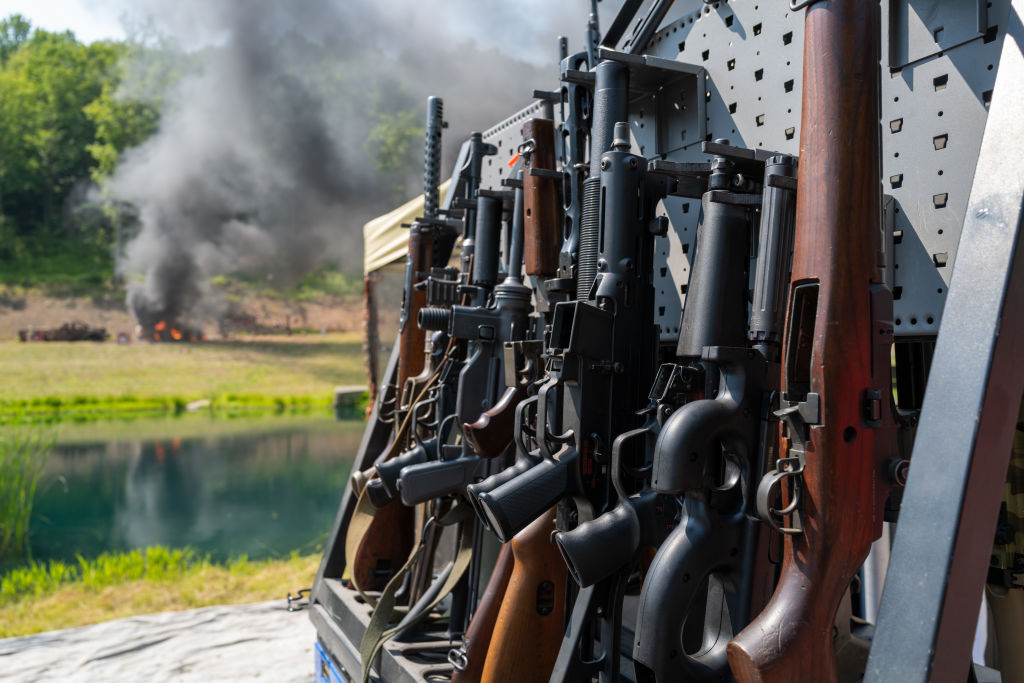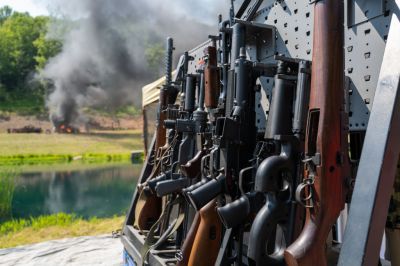One of the generally unspoken assumptions of the gun control movement is that changes in firearms technology drive changes in gun-wielding behavior—that, at least in some part, we have the kind of gun-related violence we have today because of the kinds of firearms we have available.
That isn’t really supported by the facts, which is why we are not living in a golden age of long-range assassinations.
More about that in due course.
We fixate on certain kinds of firearms for the same reason we fixate on certain kinds of automobiles or airplanes or other pieces of gear: because they are charismatic machines.
Let me explain what I mean.
Volvo is a leading manufacturer of semitrucks, but nobody says, “You look like you got run over by a Volvo heavy commercial vehicle”—it is, “You look like you got hit by a Mack truck,” the ck-consonance of “Mack” and “truck” adding force to the image. “Mac” was once a common masculine nickname; Volvo, the corporate logomark of which is the alchemical symbol for both iron and masculinity and whose name is Latin for “I roll”—together, “rolling iron”—is, in spite of all that, a distinctly feminine product in the public mind, something for safety-minded suburban PTA moms with baby seats in the back. There are certain machines that stick in the mind irrespective of whether they really stand uniquely out in their category: Gulfstream jets and Ferrari sports cars among branded machines, or chainsaws, steamrollers, and machine guns in categories of machines.
Machine guns, or fully automatic firearms, are, of course, of particular interest to my argument here. There is no doubt that firing a machine gun looks cool—that’s why machine guns are in all the movies, why there exist all those clichéd, slow-motion shots of streams of spent brass shell-casings hitting the floor in all those Matrix and Terminator movies. But, in the real world, American streets are not the scene of very much machine gun fire. There are about 750,000 legally owned fully automatic weapons in civilian hands in the United States, but you’d have to go back nearly a century to find one used in a murder. (There was at least one murder with a legal, non-civilian fully automatic weapon in 1988, when a corrupt police officer assassinated a police informant.) Illegally owned fully automatic weapons and semi-automatic weapons converted to fully automatic fire are seldom seen in murders, either, or in other violent crimes. (In some places, such as Minneapolis, illegal conversions seem to have become more common in recent years.) Gun control advocates might argue that if fully automatic weapons were more common and less tightly regulated, we’d see more of them used in crimes, and they may be right about that—but probably less so than one might think. These weapons are more difficult to conceal than ordinary handguns and typically are very expensive, and firearms with those qualities are used in violent crime relatively rarely.
In the debate about so-called “assault weapons”—meaning, in essence, any semi-automatic weapon with a removable box magazine—much of the focus is on rate of fire and magazine capacity. You hear politicians talk about how criminals armed with AR-15s are able to spray hundreds of rounds of ammunition into crowds of innocent people in a matter of seconds. Much of that rate-of-fire talk is wildly exaggerated, of course: Yes, you can dump a magazine pretty quickly with many modern semi-automatic rifles and handguns, but aiming and hitting a moving human figure is another matter entirely. But in the vast majority of violent crimes, none of that matters. Maybe criminals could fire off 100 rounds a minute with a semi-automatic rifle, but, for the most part, they don’t. We do not have great data about shots fired in violent crimes across the board, but we do have pretty good data about shots fired in altercations involving police officers. Real-world crime is not very much like Heat: In fact, the average number of shots fired by perpetrators in confrontations with police officers from 2008-17 was 5.3, according to FBI data. (The average number of shots fired in response by police officers was 18, 3.3 from the officer under attack and 14.7 from his colleagues.) The FBI estimates that the typical civilian shooting incident involves no more than three shots per shooter. Most of those rounds were fired from semi-automatic handguns, but, given that most of the criminals fired five or six shots, they might as well have been using old-fashioned revolvers. Criminals could be emptying out 30-round semi-automatic rifle magazines at police officers, but they aren’t.
The reason they aren’t doing that is, in all likelihood, the same reason so-called assault rifles are so rarely used in violent crimes at all: Like machine guns, they are not very practical. All “long guns” combined—not just semi-automatic rifles but all rifles and all shotguns together—accounted for about 3.6 percent of U.S. murders in 2016. (There were about 17,250 murders that year, with firearms used in 11,004 of them; of the murders that were carried out using firearms, long guns accounted for about 5.7 percent.) Rifles are big, unwieldy, difficult to conceal, and often more expensive than handguns. You can’t stuff an AR-15 down the front of your pants or hide one in your glovebox. For many years, the most common firearm used in a murder has been whatever the most common kind of handgun is at the time: Once it was .38-caliber revolvers, now it is 9mm and .40-caliber pistols.
Where one does see semi-automatic rifles used relatively frequently is in mass shootings at schools and other public places, though even in these situations, rate of fire and magazine capacity are less important factors than often is assumed to be the case. (A notable exception was the Las Vegas massacre, in which an elevated shooter using “bump firing” engaged in a rapid-fire attack on a relatively dense crowd.) One of the horrifying things you can experience if you go through the evidence of school shootings is that the killers typically employ deliberate, relatively slow gunfire—these are not wild orgies of violence that last a few seconds but relentless, programmatic massacres that last until something brings them to a halt.
When the first AR-15 rifle was manufactured, Dwight Eisenhower was president of these United States, Cadillacs had spectacular tailfins, and Bobby Darin’s “Dream Lover” was all over the radio. The semi-automatic version of the military rifle has been sold to civilians since the beginning of its history, marketed as a modern hunting and sporting rifle. Some improvements have been made to Eugene Stoner’s design over the years, but, in terms of lethality, the rifle hasn’t changed very much since the late 1950s—it remains a lightweight semi-automatic rifle typically firing the modestly powered 5.56mm NATO or the nearly identical .223 Remington round. Whatever has changed from the Eisenhower years until now, it isn’t the rate of fire or the magazine capacity of the AR-15 or its legions of descendants and imitators. It was, if anything, easier to walk into a store and buy a genuine AR-15 60 years ago than it is to buy one today. When it comes to shooting a lot of rounds quickly, not much has changed.
What has changed—and changed radically—is the capabilities of precision rifles. And that is what raised my question above: If gun capabilities drive criminal behavior, then why aren’t there more long-range shootings?
Here is a little peek into contemporary gun culture—like everything else, it has gone nerd: The baby boomers and Generation X may have grown up with Rambo and the Matrix crew firing thousands of rounds at the bad guys, but the cool kids down at the gun range today grew up with American Sniper—for them, the great mark of prowess isn’t being able to shoot 1,000 rounds at a go but being able to shoot one round 1,000 yards and hit the target. And that often involves some math and some tech. Last year in Wyoming, a shooter set a new world record by hitting an 8-inch steel target from 7,774 yards—about 4.4 miles—a shot in which it took the bullet 24.5 seconds to reach the target. The capabilities available to a modern precision shooter were unheard of only a few years ago: sophisticated sensors measure wind, temperature, and atmospheric pressure; ballistic software on smartphones (or embedded in riflescopes) can calculate bullet drop precisely not only for a particular caliber of ammunition but for a particular make and model, as well as account for everything from the length of the rifle barrel to the Coriolis effect. Modern precision bullets offer aerodynamic performance far in excess of most of what existed only a decade or two ago. A reasonably competent amateur shooter today can routinely make shots that would have been impressive work for a World War II sharpshooter.
When the German sniper Matthäus Hetzenauer made a 1,200-yard shot in World War II, it was a wonder; in 2017, a Canadian sniper fighting in Iraq killed an enemy from 3,871 yards—more than two miles. Meanwhile, a lot of ordinary weekend shooters with Applied Ballistics on their iPhones can match Hetzenauer’s range. But we don’t have a lot of sniper killings in the United States. (The “Beltway snipers” of 2002 were shooting from no more than 100 yards.) We have the homicidal maniacs and they have the capabilities, but sophisticated sniper attacks are pretty rare. Sniper attacks were much more common in the 1960s and 1970s, when they were an expression of radical politics of various stripes but were considerably more demanding to pull off than they would have been with modern means.
Why is that?
One reason may be technical difficulty. Many school shooters and perpetrators of similar mass-murder spectaculars are meticulous planners, but their planning seems to be part of the fantasy performance itself, as much an act of self-presentation and self-conception as it is a practical matter of organizing a bloodbath. The kind of discipline and preparation it takes to be a consistent 1,000-yard shooter calls for a different kind of attention. Obsessive people are not necessarily organized people. In a concealed carry class a few years ago, one of the students had just a lot of questions about what circumstances might make it permissible to shoot a police officer—he went on and on about it, but he also couldn’t understand why the .45-caliber ammunition he’d brought along wouldn’t go in the 9mm pistol he had.
(I hope that guy didn’t get a concealed-carry permit; but, this being Texas, he doesn’t need one now.)
But the most likely explanation for the lack of sniper attacks, or so it seems to me, is that the kind of cultural gene that lands you somewhere on the McVeigh-Klebold spectrum is different from the one that puts you on the Lee Harvey Oswald-James Earl Ray spectrum. (Charles Whitman, the Texas Tower sniper, may have been an Oswald in technique but he was a Klebold at heart.) By way of comparison, you can learn to shoot a semi-automatic rifle well enough to massacre screaming schoolchildren in a few hours. What has changed there isn’t the nature of the weapon—it is the desire to massacre screaming schoolchildren. To put it in Marshall McLuhan terms, we’re talking about the difference between hot murders and cool murders. It seems to me much more likely—maybe even obvious—that a particular kind of homicidal orientation drives the choice of weapon rather than weapon availability driving homicidal choices. Some people are born to be ax murderers.
If this all sounds like a weird tangent, it is. But it also isn’t: Almost the entirety of our gun control discourse focuses on what kinds of weapons are for sale at licensed gun dealers, even though there is almost no overlap between the population of people who do business with licensed firearms retailers and the population that commits violent crime. (Among the currently incarcerated people who were in possession of a firearm at the time of the crime for which they are imprisoned, less than 2 percent got that firearm from a licensed retailer. Why firearms dealers are regulated at all by criminal justice agents rather than by commercial regulators is something of a mystery to me.) But embedded in that discourse is a belief, however incompletely articulated, that, as they say, “It’s the guns!”—i.e., that it is the availability of technical means rather than other factors that primarily drives violent criminal behavior. Which isn’t to say that the instruments are a complete non-factor: If there were no cars, there wouldn’t be any speeding or drunk driving or illegal parking or vehicular homicide. But a lot of our fellow citizens take a different attitude toward guns, because they see the guns themselves—and the desire to possess them for lawful purposes—as illegitimate. That is why they declare, “There is no legitimate reason for a civilian to own” this or that gun, and then stuff their fingers in their ears and say “La! La! La! I can’t hear you!” when you explain the legitimate reasons to them. No matter how many times Joe Biden insists that nobody hunts with a semiautomatic rifle, people have been doing exactly that for well more than a century.
I don’t know that there is any practical reason—civilian, military, sporting, or even criminal—to be able to shoot a target from 4.4 miles away. Even the clumsiest among us can get closer to an elk than that. But the fact that people can do it—and have the guns and the other instruments to do it—doesn’t have any real relationship with crime at all. The vector of causality isn’t pointing in the direction much of the gun control debate seems to assume—and surely that matters. But we are easily transfixed by the cinematic quality of those rapid-fire weapons, however insignificant they are as a factor in real-world crime in these United States.






Please note that we at The Dispatch hold ourselves, our work, and our commenters to a higher standard than other places on the internet. We welcome comments that foster genuine debate or discussion—including comments critical of us or our work—but responses that include ad hominem attacks on fellow Dispatch members or are intended to stoke fear and anger may be moderated.
With your membership, you only have the ability to comment on The Morning Dispatch articles. Consider upgrading to join the conversation everywhere.